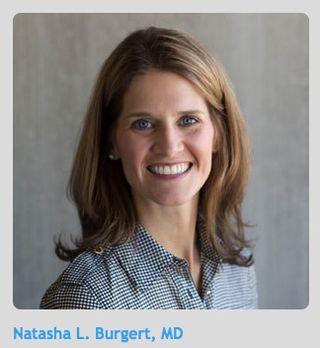Social Media | Case Studies | Personal branding | New Rules of Sales & Service | Brand Journalism | Best Practices
Recently, I wrote a post about Dr. Kate Burke, an emergency physician who uses video in her practice, shooting clips for patients at the end of an emergency room visit explaining the treatment and what to do upon getting home.
That post about the great work Kate is doing to educate patients and their families was prompted by my personal experience with terrible healthcare customer service.
Today I’m introducing another clinician doing fantastic customer service, this time via her blog, Facebook, and Twitter.
 Natasha Burgert, M.D. —- a full-time primary care pediatrician at Pediatric Associates in the Kansas City area who has a passion for educating families in unique ways through her blog and in social networks —- also noticed that the parents of her patients weren’t retaining the information she shared on visits. “The clinic space is not a good learning space,” she says. “It’s an information gathering space but it’s not a learning space.”
Natasha Burgert, M.D. —- a full-time primary care pediatrician at Pediatric Associates in the Kansas City area who has a passion for educating families in unique ways through her blog and in social networks —- also noticed that the parents of her patients weren’t retaining the information she shared on visits. “The clinic space is not a good learning space,” she says. “It’s an information gathering space but it’s not a learning space.”
Dr. Burgert uses her @doctornatasha Twitter feed, her Facebook page, and her KC Kids Doc blog to share information with parents, the teenagers she serves, and the community at large. Like Dr. Burke, she sees tremendous value in delivering follow-up information via social tools.
“If you really want to know why your kid gets a fever, what you need to do about it, what’s good, what’s bad, what are the myths and what are the facts, that’s a long discussion and quite frankly you are going to understand about 10% to 20% of what I say,” Dr. Burgert says. “So I deliberately don’t answer those questions in a visit and I say here’s three blog posts that I wrote that are going to explain all that you want to know. When your kid gets a fever then go back to it and look again, that’s the time that you are going to learn. I specifically won’t answer certain questions that I have written about because I just don’t think that’s time well spent. It’s in one ear and out the other especially when you are distracted by your kids in the office. You are worried about they are getting shots that day. Maybe they’re not feeling well.”
Dr. Burgert’s KC Kids Doc blog allows her to deliver important health information but with her personal spin and in real-time. Because she’s seeing patients every day, the content is derived from her experience in the office. “In the big machine of the Academy of Pediatrics and WebMD and these wonderful places that you can go for health information, sometimes they just don’t turn over quickly enough in order to be practically useful so that’s where the blog started,” she says. “The blogging is to specifically respond to things that I was seeing in my day to day practice life that were important to families who wanted my opinion and needed some direction, but weren’t necessarily some of the things that large health information sites were able to provide.”
For example, in discussions with teenage girls she was seeing, Burgert started to hear a few talking about “thigh gap.” So she asked the teenagers a bunch of questions and learned that girls were trying to achieve a valued “gap” between their thighs when standing with their ankles touching. For those girls without a gap, they shared diet tips and exercise routines to create one. Burgert was horrified. She did some research and noticed there was very little written using the phrase “thigh gap.” She realized she was seeing an early trend and quickly wrote a post Thigh Gap: The Newer and Disturbing Trend in Body Awareness to get the word out to girls and their parents that this is not a healthy choice. The post provides tips for parents to talk to their children about healthy body image and details signs of an early eating disorder.
“My blog, Facebook, and Twitter are a bit of real life,” Burgert says. “It’s my opinion although I try to support my comments with as much evidence based literature as I can. I think that is the beauty of having a place where you can speak your mind as a physician. We have these amazing conversations with families that I think are really, really valuable that need to be shared, especially with my teenagers. They are very open with me and honest about the concerns and issues that they have. Hopefully I can prevent other kids having troubles with that if I didn’t have that platform I couldn’t share it as widely as I do. Parents enjoy the fact that they can turn to one place that is going to have a conglomerate of both the research evidence in my opinion.”
Dr. Burgert creates the content typically in her blog and then shares links via Facebook and Twitter. But she gets the information to parents in any way they are comfortable. “Our community is very technologically savvy so many people will just look it up,” she says. “But my job is to offer as many ways to get to your hands on the information as possible. I will just text you the link or email you the link. I have bit.ly short codes for all of them. I can write them down. And I have QR codes that I pop onto my computer screen where I am doing my Electronic Medical Record, so they can just scan on screen with a QR reader. For those who don’t want all that electronic stuff, I have paper copies. It is my patient’s choice how they get that information.”
As Dr. Burgert was explaining all this to me, I was struck at the contrast between how she and Dr. Burke get information to patients compared to my physical therapist and the stick figure cartoon he sent me. In addition to providing information to patients and parents after a visit, she also anticipates what people will need prior to a visit.
“If I know that you are going to come in to me for this specific issue, I can guess what your questions will be,” she says. “I can preempt that visit by giving you answers to those questions and when we come together and we’re going to talk about how those answers are specifically relevant to your family and not general just information that you can get anywhere. I develop a plan and specifically ask those questions about what might be unique to your family. It’s important education piece to get some right framework but it’s not plan forming.”
Beyond the value her blog and social presence provides to individual patients and her families, Burgert says there is a sales aspect to what she is doing as well. “It’s beyond information distribution,” she says. “It’s actually a relationship building tool and a valued place for families who are trying to make the best decisions for their kids.”
She’s seen lots of evidence that her blog posts are shared via social media and are discussed by parents in the community, raising awareness of her practice. “That’s how my brand is marketed and that’s how people get into the clinic, bringing their families because they heard about us on the soccer field,” she says. “I can watch the tracking of how it’s being shared through Facebook and where it’s getting linked out from the blog.”
While the agile service she provides to families and the community serve to bring in new patients, she sees a much bigger role for her efforts. “A lot of people ask why I started doing it but I think the bigger maybe and more important answer is why I keep doing it,” she says. “Medicine is changing and how patients are making health decision are changing. As a pediatrician who went to school for a long time, I want to be able to use my knowledge and use my training effectively. There are new ways to distribute the knowledge that we have so I keep doing it because it provides such great value within the community and that’s an amazing feeling as a physician to think that you are improving on what’s already an amazing career by trying something new. Parents come in and say, ‘you know I was really, really worried about this. It was causing me to lose sleep and I could turn to your Facebook page and I got a lot of reassurance and calm and I could rest well.’ I often hear the comment there’s just so much information out there, but parents just want to know what I think. They have already chose me as their pediatrician, they trust me, now they just want to know what I think so they don’t have to worry about doing all of this research and investigation themselves.”
As Dr. Burke and Dr. Burgert show, it is possible to deliver excellent customer service in healthcare. I look forward to the day when the kinds of things they are doing to make patients healthy and their families informed are the norm.
Photo of Dr. Natasha Burgert courtesy of Pediatric Associates.



